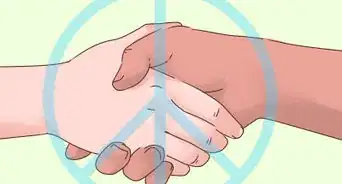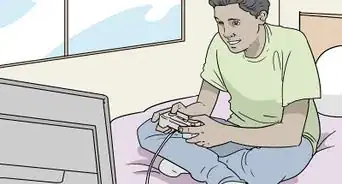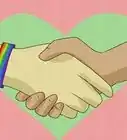This article was co-authored by wikiHow Staff. Our trained team of editors and researchers validate articles for accuracy and comprehensiveness. wikiHow's Content Management Team carefully monitors the work from our editorial staff to ensure that each article is backed by trusted research and meets our high quality standards.
This article has been viewed 162,363 times.
Learn more...
Homophobia is discrimination, fear, or hatred of gay (and often bisexual) people. It takes many forms, including acts of violence, feelings of hate, or gestures of fear. Both individuals or groups can be homophobic and can create hostile environments. Luckily, you can choose not to be homophobic. It may make time time to change the way you view the world, and it will most certainly require hard work. However, you can learn to be a more open-minded individual to create a happier, safer world.
Steps
Reflecting on Your Beliefs
-
1Write down your feelings. If you are making a conscious decision to stop being homophobic, then you may have already noticed some feelings or actions that trouble you or others. Write down your feelings or what actions trigger certain feelings of homophobia. For example:
- I feel uncomfortable and angry when I see a same-sex couple kissing.
- I think it is wrong that my sister likes other women.
- I feel it is unnatural for two men to like each other.
-
2Research your feelings. Once you have written down the specific feelings that make have homophobic feelings, it is time to analyze why you feel this way. This is a needed step to start making changes. Try and ask yourself:
- ”Why do I feel angry in [x] situation? Who or what has influenced this emotion? Is there a reason why I feel this way?”
- ”Do I think it is reasonable to feel this way? What steps can I take to not feel this way?”
- ”Can I talk to someone about these feelings to identify why I feel this way?”
Advertisement -
3Identify your beliefs. Often, our beliefs come from our parents or our mentors. When you are reflecting on your feelings, consider where your homophobia originated. Ask yourself:
- ”Do my parents feel homophobic and have their views influenced mine?”
- ”Is there someone in my life that influence these negative feelings?”
- ”Has my education/religion/research made me feel this way? Why?”
Considering Your Habits
-
1List your bad habits. Once you have been introspective on what sort of feelings you have and why, |list out specific bad behaviors that you would like to change. This might make you feel ashamed because of your past actions, but it is always best to be honest with yourself so that you can move forward. Try and list what the consequences might have been.[1] Be as specific as possible:
- ”I have a bad habit of using the word ‘gay’ to describe things. I think this can be offensive to people who identify as gay.”
- ”I made fun of [x] in high school and called him gay. This probably hurt his feelings.”
- ”I was so mean to my sister when she came out to the family. I ruined an important relationship in my life because of my hateful feelings.”
-
2List what you want to change. Be as specific as possible in this list. Once you have identified these bad habits and negative feelings, it is time to consider the positive. List goals you would like to achieve. For example:
- ”I want to stop using the word ‘gay.’
- ”I want to ask forgiveness to people I made fun of.”
- ”I want to rekindle my relationship with my sister and ask her for forgiveness.”
-
3Recognize change takes time. You should recognize that changing bad habits into good ones takes times. Experts suggest it takes about a month to develop a new habit.[2] You might make mistakes. You might revert back to some bad behaviors. The trick is to keep on moving forward and keep on trying.
Taking Action to Change
-
1Speak up against homophobia. You may have heard, or even said, “that’s so gay!” This is considered insensitive and hurtful to the LGBT community as it is a derogatory term. When you hear this phrase, try and stop people from using it by saying something like:[3]
- ”Do you know what that phrase means?”
- ”Why do you use that phrase?”
- ”Don’t you think that phrase can be hurtful to others?”
-
2Respond to homophobic statements. Unfortunately, it has been well recorded that homophobic slurs are commonplace, especially in schools and on campuses.[4] When you hear a homophobic slur or statement, make sure you respond to them in a rational and respectful manner. When you hear something negative such as “gays go against God’s plan” or “all gays are pedophiles,” adopt some of the following techniques to successfully deal with this speech:
- Be matter-of-fact. Once you include emotion into your voice, it can be easy for others to not take you seriously. Speak with facts and with a level head so that your message is more likely to be heard.
- Explain why what was said is hateful. Sometimes, people speak without realizing that their words have meaning. Explain why what a person said was hateful and perhaps she will understand the error of her ways.
- Say that there is nothing wrong with being gay or a lesbian. This positive attitude can show that you have support for others.
-
3Stand up for others. Bullying is a serious problem. If you see/hear hateful slurs, hateful speech, or hateful actions against someone (whatever their orientation is), stand up for them with a message of support. Be confident and say something like:[5]
- ”I really do not like what you are saying about [x]; that is very hurtful!”
- ”Why would you say or do that? How would you feel if that was done to you?”
- ”I really do not think we can be friends if you continue to talk like that.”
-
4Learn from past grievances. 76 countries in the world currently have laws that persecute gay or lesbian couples.[6] History has shown discriminatory and hateful practices against the LGBT community. Take the time to learn about some of these grievances to gain a better perspective on what this community has to face.
- Many time periods in history have records of homophobia. For example, during WWII, Nazi Germany placed gay people in concentration camps. Learning facts can help put this hatred into perspective and perhaps allow you to learn to be more tolerant because of them.
- You can learn about history through a number of means including documentaries, podcasts, textbooks, and the internet.
Pushing Your Boundaries
-
1Talk to a gay person. Once you are starting to feel comfortable with your own feelings, it is time to push yourself to change. Try to talk to and have a conversation with a gay person. Be respectful and nice, and do not ask pointed questions about his sexuality.
- Just have a normal conversation and try and keep an open mind about the person you are talking with.
- Try neutral social questions such as: “Can you tell me about your job?” or “What sorts of movies do you like to watch? or “What is your favorite restaurant?”
-
2Go to a LGBTQ advocacy meeting. It is hard to put yourself in other’s shoes and understand how others are persecuted.
- To help broaden your mind, try going to an advocacy meeting, rally, seminar, or lecture specifically aimed at gay/lesbian rights. Again, it is important to be respectful to others, regardless of your own views.
- To find the locations for such meetings, check flyers at a local college campus. College campuses generally have a more diverse community and often host meetings/lectures/seminars.
-
3Push yourself to make a new friend. Once you start to broaden your mind and exercise good habits, try making new friends who identify as gay. Talk to someone who shares your own interests and hobbies, and be yourself!
- Making a gay friend is just like making a heterosexual friend. Find someone who shares similar interests as you and let a friendship grow organically.
References
- ↑ https://www.nlm.nih.gov/medlineplus/magazine/issues/spring12/articles/spring12pg18-19.html
- ↑ https://www.psychologytoday.com/us/blog/headshrinkers-guide-the-galaxy/201109/theres-only-one-way-change-slowly-over-time
- ↑ https://www.gov.nl.ca/education/files/k12_safeandcaring_pdf_responding_sexism_homophobia_transphobia.pdf
- ↑ http://www.healthiersf.org/LGBTQ/InTheClassroom/docs/Responding%20to%20Homophobia.pdf
- ↑ https://www.plannedparenthood.org/learn/teens/bullying-safety-privacy/bullying/what-if-i-see-someone-being-bullied
- ↑ http://www.un.org/apps/news/story.asp?NewsID=47815
About This Article
In today’s society, it can be hard to filter out hateful ideas about people who are different, but with some practice, you’ll be able to change your habits and stop being homophobic. Whenever you can, try to notice bad habits you have so you can change them. Maybe you call things “gay” or make fun of people who are gay. It may take some time, but if you set out to stop doing those things, eventually you can. It’s also important to speak up against homophobia when you see it. If someone uses a hateful slur, you could say, “Don't say that. There’s nothing wrong with being gay.” If you don’t have any gay friends, consider talking to a gay person. Keep in mind that gay people just wanted to be treated like anyone else, so don’t just focus on their sexuality. Instead, talk about regular topics, like work, school, or TV and movies. To learn how to figure out where your homophobia originated, read on.




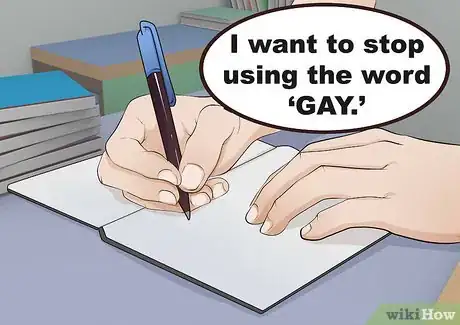

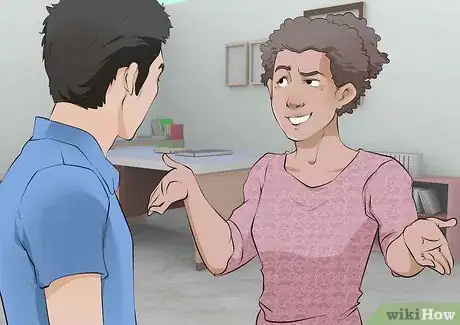

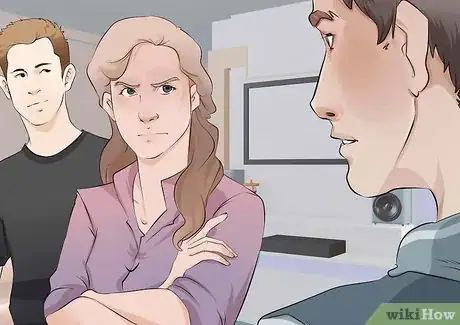





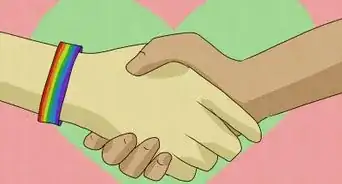


-Step-14-Version-2.webp)
-Step-16.webp)



